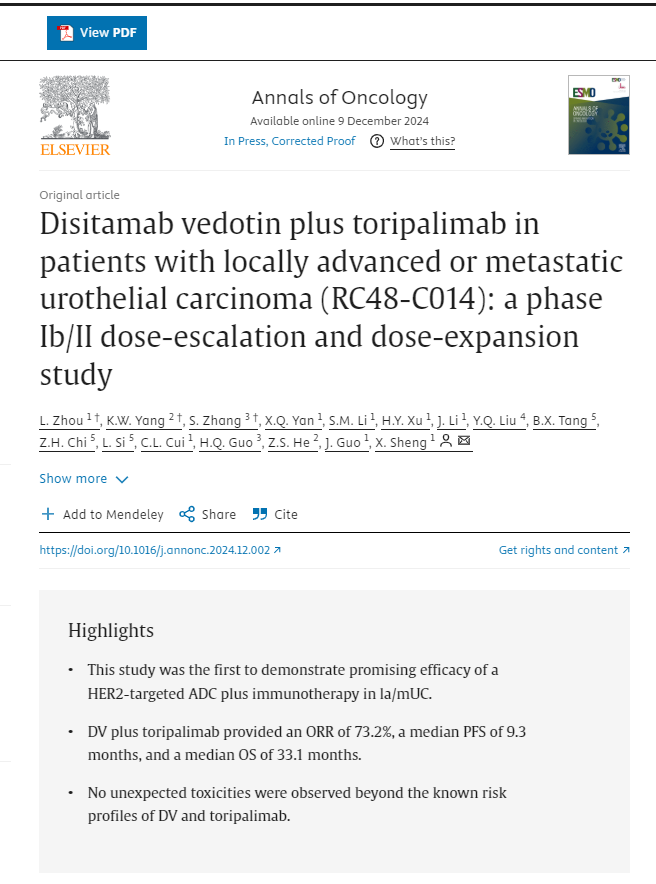On January 7, 2025, Annals of Oncology (IF: 56.7), a top oncology journal globally, published a full article on a phase Ⅰb/Ⅱ clinical trial (NCT04264936, study ID: RC48-C014) on Disitamab Vedotin (DV) combined with Toripalimab in treating locally advanced or metastatic urothelial carcinoma (la/mUC) performed by Professor Jun Guo, Professor Xi’nan Sheng and their team from Peking University Cancer Hospital.

It is the first time that long-term follow-up data has been released for a HER2-targeted antibody-drug conjugate (ADC) and PD-1 inhibitor combination therapy in treating la/mUC, marking a significant milestone. The nearly-three-year follow-up revealed an objective response rate (ORR) of 73.2% and median overall survival (OS) of 33.1 months, superior to any prospective clinical study on ADC plus PD-1 inhibitor therapy for la/mUC with data published.
New Treatment Options for Patients with La/mUC
Urothelial carcinoma (UC) is the most common cancer worldwide.GLOBOCAN 2022 estimated the year 2021 saw 614,298 new cases and 220,596 deaths of UC. In recent years, the prognosis for patients with la/mUC has significantly improved with new drugs and combination therapies approved, among which ADCs stood out for their huge potential.
According to a multicenter, large-sample real-world study led by Fudan University Shanghai Cancer Center, HER2 overexpression (IHC 1+/2+/3+) was detected in 81.4% of UC patients in China. As a HER2-targeted ADC, DV has been approved in China for patients with HER2-overexpressing (defined as immunohistochemistry [IHC] test results of 2+ or 3+) la/mUC previously treated with platinum-containing chemotherapy. The approval is based on the pooled results of two studies (NCT03507166 and NCT03809013, study IDs: RC48-C005 and RC48-C009) where the ORR registered 50.5% and the median duration of response (DOR) registered 7.3 months.
Multiple clinical studies on la/mUC in recent years have confirmed the synergistic antitumor effects of ADC combined with immunotherapy. NCT04264936 offered stronger evidence as its long-term follow-up results published in the Annals of Oncology demonstrated the high response rate, significant survival benefits, and manageable safety profile of the DV and Toripalimab combination therapy.
DV Combined with Toripalimab: High Response Rate and Prolonged Survival
NCT04264936 is an open-label, multicenter, investigator-initiated phase Ⅰb/Ⅱ clinical trial investigating the safety and efficacy of DV in combination with Toripalimab for the treatment of patients with HER2-expressing la/mUC. The dose-escalation study (phase Ⅰb) assessed two dose levels of DV (1.5 and 2.0 mg/kg) combined with Toripalimab (3.0 mg/kg) to determine the recommended phase Ⅱ dose which was then evaluated in the dose-expansion stage (phase Ⅱ).
From August 2020 to December 2021, 41 patients were enrolled with a median age of 66 years. 53.7% of the participants were male, 70.7% had an ECOG performance status score of 1, 17 (41.5%) had lung metastasis, and 10 (24.4%) had liver metastasis.
As of March 1, 2024, among all participants, the ORR was 73.2% with 4 (9.8%) achieving complete response and 26 (63.4%) achieving partial response, the DCR was 90.2%, the median progression-free survival (PFS) was 9.3 months, the median DOR was 8.6 months, the median OS was 33.1 months and the 36-month OS rate was 49.2%.
Subgroup analysis revealed ORR benefits across all subgroups regardless of the number of prior lines of systemic treatments, HER2 expression (IHC 1+/2+/3+), and PD-L1 expression status. The ORRs for chemotherapy-naïve patients and those who progressed on platinum-based chemotherapy were 76.0% (19/25) and 68.8% (11/16), respectively. The ORRs for patients with HER2 IHC 3+, 2+, 1+, or 0 were 80.0%, 84.2%, 64.3%, and 33.3%, respectively. Compared with the three HER2 IHC 0 participants (one of whom achieved partial response), those with HER2 expression (IHC 1+/2+/3+) had a higher ORR (76.3% vs 33.3%) and longer PFS (median PFS: 9.3 vs 1.7 months).
The DV and Toripalimab combination therapy has preliminarily demonstrated promising efficacy and manageable safety profile among patients with la/mUC, wherein those with HER2 expression (IHC 1+/2+/3+) have achieved high response rates and long-term survival benefits. These findings support the further exploration and validation of the benefits of DV combined with PD-1 inhibitors in treating la/mUC.
